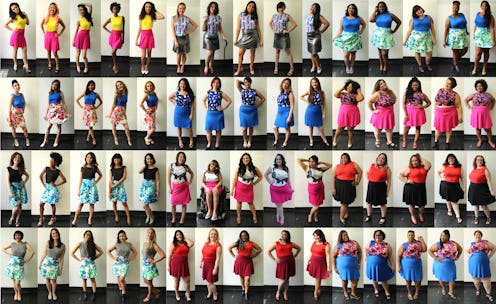Fashion
The #InYourSize Campaign Is Size Inclusive Magic

It'd be a fair argument to claim that every SmartGlamour campaign is rooted in body positivity, considering the entire brand is based on inclusive representation. But the e-retailer's latest endeavor, SmartGlamour's #InYourSize campaign, champions size diversity in a way that no other brand has done before. The idea seems simple at first. But when the concept is realized, many might observe a tangible change in the way they perceive clothing sizes.
SmartGlamour currently offers 12 sizes — XXS through 6X — but rather than use 12 models to represent these clothing sizes, the brand used 60 models instead. Why? To prove that the "clothing size is just a number" trope is entirely true. Each and every one of these individuals looks completely different from the next; and yet, differently sized and shaped women will still fit into one clothing size.
Be it because of height, weight, or even weight distribution, the reasons we rock the sizes we do come down to so much more than a line between straight and plus sizing — and this SmartGlamour campaign only proves it. Although its campaigns usually use incredibly diverse models, utilizing 60 different individuals for the #InYourSize project is the logical next step for Mallorie Dunn, SmartGlamour's founder and designer who is known to continuously call out lack of standardized sizing in the fashion industry.
The point here is clear: Your clothing size means very little in regards to your body's shape, size, or weight.
In the press release for #InYourSize, Dunn commented on her inspiration for this particularly size inclusive campaign:
"The powerful images illustrate how differently our bodies are from one another — even though we all 'fit' into set sizes on size charts. Through casting this campaign, I realized that over two thirds of all the applicants were between sizes — something I've definitely noticed through my customers as well. All of this reinforces our message that sizes hold no intrinsic value — they only measure the amount of fabric [and] thread that goes into a piece."
What Dunn has been doing with her brand, as well as with campaigns like these, is try to impress upon the public just how unnecessary it is to worry about one's clothing size — especially when clothing sizes aren't standardized; especially when five fairly different bodies can fit into the same exact clothing size; especially when the size of our bodies or our clothes should have no bearing on our self-worth.
In SmartGlamour's blog post about the #InYourSize campaign, the brand went on to express that most people — two thirds of its models, if you want the figures — are actually in between sizes. "A size chart is just that — a chart. But bodies don't come off of conveyor belts in factories. We are not robots — we're humans — with many more measurements than just bust, waist, and hip," wrote Dunn. "There are well over 300 million people in the U.S. — but there aren't that many sizes — so it is inevitable that you might end up not fitting squarely on a chart."
This campaign is evidence that all bodies are completely different, so it should follow that our clothing sizes be different as well. Ultimately, purchasing clothing should be about what fits most comfortably. Because as Dunn put it, sizing is only about measuring the "fabric and thread" of a piece. It's simply not about your value as a human being.
Images: Courtesy SmartGlamour